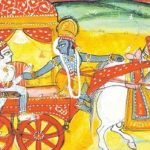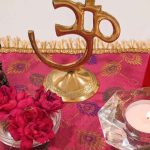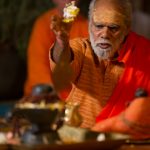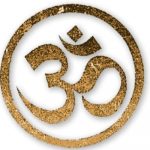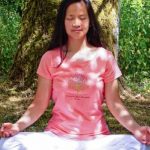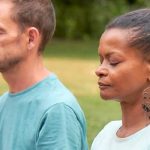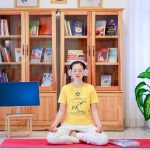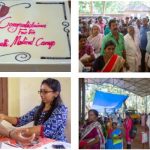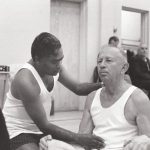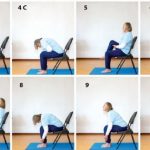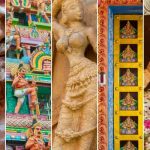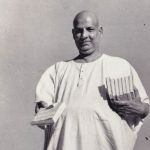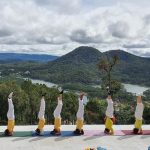 How to Overcome your Inner Limitations
How to Overcome your Inner Limitations
By Swami Durgananda
Through regular Sadhana your life will experience a shift of consciousness, a shift of awareness. You notice things you never noticed before within yourself and also within nature all around you. You recognise that you are actually a spiritual being, it means you are part of everything. You are part of nature, you are part of this universe.
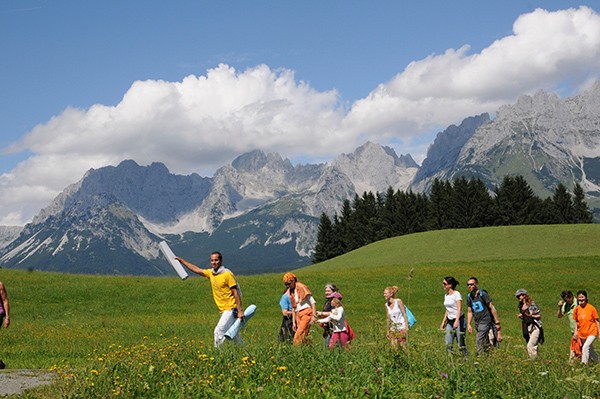 Swami Vishnudevananda, our teacher and founder of all the Sivananda Yoga Centres worldwide, had a vision in the late 1960s. He had been sent by Swami Sivananda to the West to teach Yoga, but Swami Vishnu did not really know what to expect as he had never been to the West and he was unsure what to do. Then he had a vision whilst meditating, which physically shook his body with its strength.
Swami Vishnudevananda, our teacher and founder of all the Sivananda Yoga Centres worldwide, had a vision in the late 1960s. He had been sent by Swami Sivananda to the West to teach Yoga, but Swami Vishnu did not really know what to expect as he had never been to the West and he was unsure what to do. Then he had a vision whilst meditating, which physically shook his body with its strength.
He saw suffering, he saw cities on fire, millions of people running, escaping, babies being delivered on the way. Visions can take some time to manifest, because physical life is much slower than astral life, but we recognise Swami Vishnu’s vision today in the world around us. From his vision, he knew he had to do something, and realised what his master had meant. He set about establishing the Centres and Ashrams, naming them “Sivananda” out of devotion to his guru, and started training people in the techniques of yoga.
The vision led him to create a training programme in yoga on a grand scale. He started quickly, and within 10 years we had ashrams and centres in America, Europe, India, and Australia. He taught non-stop, with the first organised Teachers’ Training Course in 1969. The course originally lasted six weeks, it is now four weeks, and rather than create a yoga “profession”, it is intended to pass on techniques for people to manage their own suffering, to suffer less, and create a personal Sadhana.
Once you have this in your own life, you can pass it on. Swami Vishnu said you should teach in your own community, in your schools, wherever you are working – and people do. Now we have thirty nine thousand teacher trainees worldwide, and they teach, and so it multiplies. In addition to the Teachers’ Training Courses, Swami Vishnu created the “Yoga Vacation”, quite familiar to us as a concept now, but he was the first to invent it. He saw how people would “escape” to the country for their holidays, and said, “Let’s make use of this, when people have time, to teach them yoga.” Swami Vishnu said “teach”.
Inner peace can be experienced through the practice of yoga, and that is what the masters are trying to convey to us.
There is no competition, just teach. Learn to cultivate your character. Remove self-centeredness and develop divine radiance. These are just words, but the feeling within tells you when you get closer to that divine radiance because peace and harmony will go side-by-side. Then outer actions and language reflect your inner character and show where your heart and mind are. That is why in yoga we also watch the impulses.
Swami Vishnudevananda would say, “roll back your tongue”, at the beginning, when you still have these impulses of wrong language. You can’t speak when you roll your tongue back! Through regular Sadhana your life will experience a shift of consciousness, a shift of awareness. You notice things you never noticed before within yourself and also within nature all around you. You recognise that you are actually a spiritual being, it means you are part of everything.
You are part of nature, you are part of this universe. That is the idea of Brahman-hood, of this oneness. Swami Vishnu would speak of the seven instincts: lust, anger, hatred, jealousy, greed, pride, and a very big one, fear. All of these are within us, you might say sleeping within us, unknown. But when they appear, we identify with them and we think we are that. This is a mistake, what yoga calls avidya, ignorance of our true Self. These instincts veil us completely.
But if we watch nature around us, the animal kingdom and so on, we see that these instincts are also very much present in them. They are just camouflaged in human beings because of the way we are educated, the way we dress and the way we speak. We think we have overcome these instincts, but we have not. When we are challenged, they come out. We call it in yoga “the untrained mind.” The untrained mind is reacting and identifying with these instincts.
It leads to fighting, wars, negativity. Consequently we feel isolated. We isolate ourselves in groups, and we feel depressed and unhappy. This is what we see, particularly now in this Iron Age, (Kali Yuga) the term that yoga philosophy gives the period of time in which we live. Inner peace can be experienced through the practice of yoga, and that is what the masters are trying to convey to us. Then, the reflection of that feeling of inner peace radiates out – wards and helps towards community peace, and so on.
At the moment you see the opposite taking place. Yoga can help but we need to train the mind, and this is not easy. Yoga is a self discipline, it is not an imposed discipline, you impose it on your – self, and this gives you tremendous strength and will-power. Those who have learned will-power in their early age have a big advantage. Sports, music and a good school all help a youngster to cultivate will-power. Often, though, parents and teachers lack will-power themselves and in order to encourage self-discipline in a group, it takes a lot of will-power from the teacher.
Swami Vishnu would speak of the seven instincts: lust, anger, hatred, jealousy, greed, pride, and a very big one, fear. All of these are within us, you might say sleeping within us, unknown. But when they appear, we identify with them and we think we are that. This is a mistake, what yoga calls avidya, ignorance of our true Self.
It takes courage to go beyond that emotional, sensual life. It takes courage to practice yoga, to cross certain barriers of yoga. The easy yoga is just up and down, left and right. But to cross certain borders in yoga also takes courage. What hinders us from crossing these borders? The stagnation of life, fanatic perceptions, old habits from unaware lifestyles, and of course laziness. These prevent us reaching beyond certain points. So emotionally, intellectually and culturally we build barriers, and they need to be broken down. It takes will-power, self-discipline and a lot of courage.
We want quick fixes, quick methods, like when you have a story and you want to know how it ends so you start at the back of the book. People want to learn how to overcome their dilemmas in life so they start from the back with everything. This can only give a shallow result and shallow understanding, which leads to our second problem: the real understanding of what life is and of our spiritual life takes a long journey.
It can be discouraging to hear “it takes lifetimes” when we have to deal with our life now, but even if the results come slowly and we feel like a snail crawling, it doesn’t matter. Something is happening. Inner awareness indicates whether we have developed, and as Swami Vishnudevananda said, the sign of inner awareness is how much selflessness is being expressed. How much selflessness are you expressing? Not how much do you want to express, but how much is coming naturally from within? How much simpler have you become in dealing with your life?
That is also some – thing to be observed. Simplicity, real simplicity, comes out of awareness. How much love do you have for your fellow man? That is very difficult, to love thy neighbour as thyself. It grows as inner awareness grows. These are signs of your inner awakening. The body and mind are like vehicles which can drive us on our inner journey. Yoga takes good care of the body and mind, not because of attachment to any sensual pleasures, but because we need these two vehicles in order to achieve inner aware – ness. Swami Vishnu would constantly remind us that yoga has different levels even though he is known as a big Hatha Yoga teacher.
First is the physical level, second the emotional level, and third there is the spiritual level. This is what we learn about in more detail in the Teacher’s Training Course. At a physical level we have the asanas. They lubricate the joints and keep the body healthy. They also have influence upon the emotional level, although it is pranayama which primarily takes care of the emotional level. Pranayama is more difficult for people to practice because the results are less tangible. You need a certain focus and you also need a certain technique so you need a good teacher to show you.
It is further complicated because you progress slowly and your lung capacity may be diminished, and the tension of your solar plexus may be immense. However, it is very important because in our society now in this age, many people are emotionally not fully developed, which means they are not in control of their emotions and they are not even aware that they are emotional. This is a big hindrance if you want to go further up the ladder in yoga.
To take care of the physical level is easy, we understand why we need to do asanas because we want to walk, we want to be flexible and have good digestion, we want to enjoy food, and sleep well. The emotional level, however, often gets pushed towards the medical route. You go to a psychiatrist or a psycho – logist to take care of your emotional level but in a lot of instances pranayama will deal with the emotional level very well. Swami Vishnudevanda used to say that half an hour of pranayama is essential every day.
It cools your brain and it controls the impulses of the mind and therefore it controls the individual ego, the instincts. We go to yoga schools and yoga masters to learn this. Then the third part is the spiritual level. This is actually the cream in the cake, and to reach the cream you have to go through the basics. The spiritual level is meditation, be it in the form of prayer, inner reflection, repetition of mantras, rosaries or malas, and studying scriptures. Our Easter 2016 retreat was based on the Narada Bhakti Sutra which is a small bhakti scripture.
When you become aware of your real inner freedom and you become aware that your instincts are controlling you, this is a big step forward.
Bhakti is not very fashionable nowadays, but it is needed to soften the ego. Swami Sivananda taught integral yoga, meaning you would experience all three of these levels as you practice. Then you experience some inner peace, you become more aware and gain real freedom. Freedom does not mean you can say what you want, eat what you want or do what you want. That is not freedom, rather it will give you even more boundaries.
When you become aware of your real inner freedom and you become aware that your instincts are controlling you, this is a big step forward. Swami Vishnudevananda would say, “Be the witness of your own movie.” When you reflect on your day and start to see where your emotions or instincts have taken over, where they have caused suffering, then you can start to realise what you really are, to feel ‘oneness’ with all. Then compassion comes. It’s not that you say, “Oh I want to be compassionate now.” It’s not from the intellect, it comes from inside, without thinking about it. Compassion has nothing to do with the intellect.
You cannot think “I am compassionate now,” or “I am devotional now”. Swami Vishnu, when he walked through the ashram in Canada, would fold his hands to greet people as is the habit in India. The way he did it was more than habit, he made you feel so welcome. It was not done with the intellect, “I have to greet this person now”, rather it was done with compassion, love and devotion for that being entering that place. In the West we also have our ways of showing compassion, love and devotion.
Pure yoga is something no teacher, no master, no guru can give you, only your own effort and your own hard work.
The ego melts and the yogi is born. It will bring peace to the family, to the community, all around. With will-power, this can be achieved. In 1986, Swami Vishnudevananda would tell us how the forces around us are very negative: mental and physical energy is depleted and will-power is weakened in the present Dark Age. In those days, when we were listening to his lectures, things were still quite alright, we still had flower power and things seemed ok. Now we know what he meant.
We are currently transcribing talks that Swami Vishnu gave onto CD and paper, and in the most recent I have read he is talking about Sadhana during the Iron Age, the Dark Age we are in now. There are four ages according to the Vedas, and in the Bhagavad Gita, Lord Krishna talks about it, and we are now in the darkest age. Well, hearing this in the seventies, we wondered, in the eighties, maybe we saw a little bit what he meant when we learned about AIDS, and now it is becoming very apparent.
Swami Vishnu said it would be very difficult for the individual to move on in their spiritual practice, to practice at a physical, emotional, and spiritual level. “It is difficult to plough on in this negative field of darkness. Only through god’s name you will be able to move on through this dark time. What is happening to this world at present, we can’t even describe. Imagine in a few more years we enter into our next century. We do not know what kind of calamities, evil and negative energy we will have to face.
This world is getting darker and darker. Our energy and will-power are also depleted because of the Dark Age.” Swami Vishnu said this in 1986. He had compassion for us, he would encourage us to get up to do our Sadhana, saying: “Remember it’s the Dark Age, it’s difficult. Our energy and will-power are depleted because of the Dark Age. People do not have strength to meditate, to do asanas, to do pranayama, and few people are able to do early morning meditation.”
So this is why he started all the Centres and Ashrams, so you can train in a positive direction. We know it’s hard. You also know. But at least you are here and you are working on your will-power. He continues: “But you have also moved in a positive direction quite far and quite fast.” What he means by that is, if you make a little effort in these difficult times, it counts a hundred times more because the forces against you are very negative; anything you do to counteract this has its effect multiplied.
Swami Vishnu also spoke about experiencing your own inner peace, and how this is how you come to know real yoga. Pure yoga is something no teacher, no master, no guru can give you, only your own effort and your own hard work. He used to say this a lot. There is often a crossroad that people come to once they have learned the methods, either they become steady in their efforts and practice, or they don’t, they are not really sincere and they start criticising and blaming others.
Negativity takes over and then people stop, sometimes over a little thing, for example Western students who visit the Indian Ashrams expect raw foods and salads, which of course are very difficult to obtain in the Himalayas where barely a car will reach. So they stop following their course, after all the effort it has taken to get to India in the first place, the money they have saved, the travel arrangements, the packing. There are lots of obstacles if the three levels are not practiced.
In 1984 Swami Vishnu said: “Success in yoga will be rapid if you put your maximum energy in your yoga practice. You must have a keen longing for liberation, an intense vairagya (dispassion), and you must be sincere and earnest in your meditation.” Now you can see the interrelation between your physical body and your physical flexibility, and mental flexibility. We talk a lot about this and it takes not only flexibility but courage. You have to adjust.
All of a sudden your mind says: “I’m going to take the Teachers’ Training Course, I’ll go to India, but I’ll take my own mind with me and I want raw food”. Then you realise that things are different in the Himalayas and that you will need to be flexible. Physical flexibility and mental flexibility become one. They feed each other. We do physical exercises to achieve mental flexibility. “When you start doing pranayama and asanas, your energy, or prana, will build up and you will see a power in your body as it becomes actively magnetised by this power.”
Swami Vishnu said this in 1968, a time when the use of drugs was widespread. Acid had arrived, and even professors from the universities were taking acid in order to find out about their mental powers. Swami Vishnu spoke out against these drugs, and he would do a lot to help people who were on drugs. People would come suffering from drug addiction, and he would give them asanas and pranayama, he would help them to fast to cleanse their system.
He warned them to expect flashbacks and that the drugs would be in the astral body and would take more than one lifetime to clean. Swami Vishnu was really in the midst of things during that time. He met the Beatles and taught them the headstand, and warned them about drugs. He tried to help everyone he came into contact with. Lots of people would come and Swami Vishnu would help them to come clean of drugs. He saved many lives like this, and received many, many letters of thanks, I remember.
He said it was a real problem that the West had started to allow these drugs to be seen as acceptable when they are so destructive. There are more talks which are in the process of being transcribed to give us strength in this Dark Age, because we need not only the technique, but to support each other in our practice. That is what the Centres and Ashrams are doing, Swami Vishnu’s gift to us.
Swami Vishnu said: “Success in yoga will be rapid if you put your maximum energy in your yoga practice. You must have a keen longing for liberation, an intense vairagya (dispassion), and you must be sincere and earnest in your meditation”.
Swami Durgananda is Yoga Acharya (spiritual director) of the Sivananda Yoga Vedanta Centres in Europe.
e-mail: [email protected]





